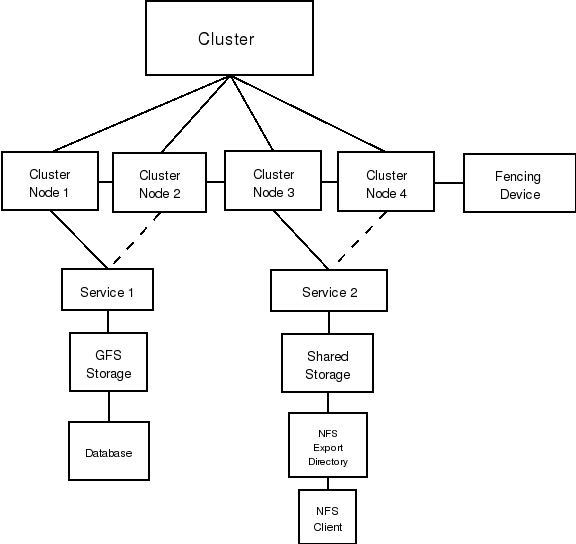3.3. Configuring the Cluster Software
Before describing the steps to configure the cluster, the hierarchical structure of cluster members and resources needs to be considered. Cluster members and resources can be thought of in terms of a hierarchical structure, as shown in Figure 3-5.
The cluster is comprised of cluster nodes. The cluster nodes are connected to a fencing device. Nodes can be separated by failover domains to a cluster service. The services are comprised of managed resources, such as NFS exports, IP addresses, and shared GFS partitions. The structure is ultimately reflected in the /etc/cluster/cluster.conf XML structure.
The steps to configure the cluster software consist of the following:
Run the Cluster Configuration Tool on one cluster member.
Click on the Cluster property and click the Edit Cluster Properties button. Enter a name for the cluster in the Name field. The name should be descriptive enough to distinguish it from other clusters and systems on your network (for example, nfs_cluster or httpd_cluster). The Config Version field should be set to 1 by default and is automatically incremented each time you save your cluster configuration.
To add a cluster node, click the Cluster Nodes property, then click the Add a Cluster Node button. Enter a cluster name that you can remember (such as the hostname assigned to the node, if any). Then click the amount of Quorum Votes you want to assign to the system.
Click on the Fence Device property and click the Add a Fence Device button to configure a fence device. Choose the device from the supported list in the drop-down menu. Each device has different configurations that you must enter (such as Name, IP Address, Login name and Password, if applicable.
Click the triangle next to Managed Resources, and click the Failover Domains property to set up one or more failover domains, if needed. Failover domains restrict the members on which a cluster service can run or restrict the order of members followed when a cluster service fails over from one failover domain member to another. Refer to Section 3.6 Configuring a Failover Domain for details.
Configure the Resources to be managed by the cluster, specifying any IP addresses, file systems, NFS exports, or user scripts to be managed by the cluster. Refer to Section 3.7 Adding Cluster Resources for more information.
Configure a failover domain for the cluster service. Additionally, configure the cluster service using the available cluster resources, or create private resources used exclusively for the that service. Refer to Section 3.8 Adding a Cluster Service to the Cluster for more information.
Save cluster configuration changes by selecting File => Save. When you save the cluster configuration, the command service rgmanager reload command is executed to cause the cluster software to load the changed configuration file.
Quit the application by selecting File => Quit.
Running the Cluster Configuration Tool for the first time causes the cluster configuration file /etc/cluster/cluster.conf to be created automatically.
Copy the /etc/cluster/cluster.conf file to the other nodes using the scp command.
